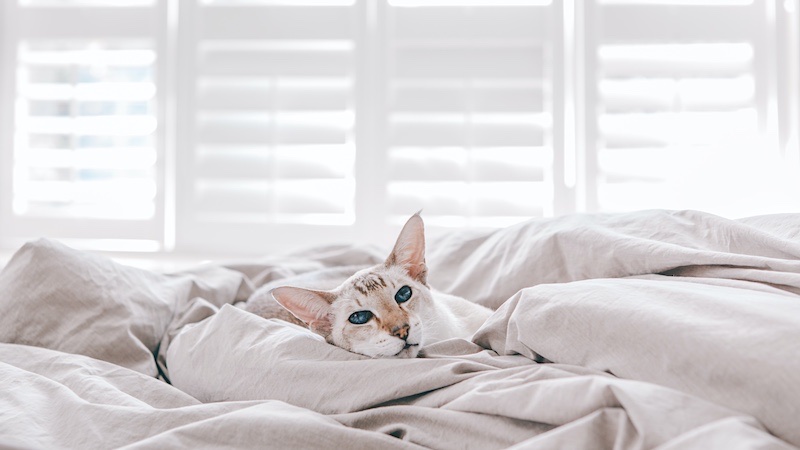Having an indoor cat can be an incredibly rewarding experience, but it can also bring a few challenges. One of the most common struggles that pet owners face is finding ways to stop a cat sleeping on their bed.
Fortunately, there are some simple strategies you can use to help discourage your feline from snuggling up with you at night and sleeping on their own bed. In this article, I’ll provide helpful tips on how to keep a cat off your bed and create clear boundaries for your pet.
First though…..
Why Does My Cat Always Want To Sleep In The Same Bed As Me?

Many cat owners are familiar with the struggle of finding a comfortable and cosy spot to sleep while their cats snuggle up in the middle of their bed. While it can be difficult to keep your cat off the bed, understanding why they are so determined to sleep there is key.
Cats naturally prefer cozy spots with enclosed walls that provide warmth, comfort, and security. Your bed may offer these elements, making it an ideal place for cats to settle down for the night.
Cats may also associate your scent with safety and protection which explains why they feel secure curling up next to you. Additionally, many cats often like being close to their owners and enjoy cuddling up in your bed as a way of staying close throughout the night.
Why You should Keep Your Cat Off The Bed
Many cat owners may think that allowing their furry friend to sleep in their bed is a sign of love and affection. However, there are several reasons why your cat should not be allowed to sleep in your bed, especially if you prefer clean sheets and a peaceful night’s sleep.
Here are 6 reasons why it is best for both you and your cat if he or she stays off your bed:
First, cats can carry diseases such as ringworm. Even though indoor cats tend to have fewer parasites than those that roam freely, some indoor cats can still get these parasites which can be transmitted to humans.
Second, cats may leave behind fur on the sheets and pillowcases throughout the night which can cause allergic reactions for some people.
Third, cats may become disruptive during the night by jumping around or meowing loudly when they want attention.
Fourth, cats may get into fights on the bed if you have more than one in the house.
Fifth, your cat may mark his territory on your bed during the night whilst you are asleep.
Finally, your cat may scratch up the furniture in the room or even start knocking things off your dresser during the night.
A Word About Ringworm
All cats can carry parasites and Ringworm in particular can be spread via contact with infected cats and their bedding.
Ringworm is a type of fungus that causes itchy skin rashes, hair loss, or scaly patches on both humans and animals. It’s an incredibly contagious infection that can spread between species, so if your cat has ringworm and they sleep on your bed, you’re very much at risk.
Cats of all shapes and sizes can be susceptible to catching ringworm, even if the cat is an indoor-only kitty.
Obviously if your pet is an indoor cat then his chances of catching something like ringworm are very much reduced although it does still happen.
Fortunately, proper hygiene and regular check-ups for your cat will help reduce this risk significantly. Frequently cleaning their sleeping areas (including yours!) will also help keep things clean and safe for everyone.
How To Keep Your Cat Off The Bed
The first step is to create a designated sleeping area in a corner of your room specifically for the cat. This should include their own bed and some enticing cat toys that will encourage them to stay put at night.
Most cats understand plenty of words (they just pretend not to), and no is usually among them. Tell your cat no every time they jump on your bed and be firm by pushing them off your bed when you say no. After some time, they’ll learn that that they shouldn’t jump on your bed.
Additionally, try strategically placing items such as chairs around the perimeter of your bed so that cats don’t have easy access. Finally, reward good behavior when they do stay off the bed by providing treats or extra attention during playtime.
To keep a cat off the bed and other furniture they don’t belong on, try setting up a cat tree in areas where they usually frequent. Make sure the cat tree is covered in materials that cats like to scratch, such as sisal rope or carpeting.
If you can’t keep your cat off the bed some cat owners claim that it’s easier to just make the bedroom a cat free zone, especially with an older cat who’s set in his ways.
Deterrents: Creating an Uninviting Environment
In order to help keep your cat off the bed you should begin by ensuring that all bedding is washed regularly. This will help to eliminate any residual odours that may be acting as an attractant for the cats.
Deterrents such as double-sided tape or aluminum foil on certain areas of the bed can be highly effective in preventing cat jumps. To ensure that cats stay away from your bed, it’s important to make sure that they never get rewarded with any attention or treats if they do manage to make their way past your deterrents.
In this way, they will be discouraged from returning and learn that being on your bed is not a desirable place for them to be.
Natural Alternative Repellents:

A natural cat repellent offers an alternative approach to keeping a cat off the bed. If you’re looking for a way to keep your bedroom area cat-free without using chemicals or harsh deterrents, these natural repellent techniques are worth trying.
To start with, discover what type of scent your cat doesn’t like. Cats are highly sensitive animals and strong odours can act as an effective barrier against them.
Does he turn his nose up when you have your morning coffee? How about when you peel an orange or chew peppermint gum?
If not then try Vinegar, Cinnamon, Citronella, Cayenne Pepper and Lavender, all known to deter cats.
Like us though, a cats sense of smell changes with age so what works on one cat may not on another so it’s important to try different doors until you find one that works on your cat. Once you hit on an odour that seems to work you should only use very small amounts.
Place orange peelings or some citrus scented sprays on and around your bed (or whatever odour you find your cat doesn’t like) to encourage them to stay away. Just a few drops of essential oil or a few sprays if you have made one my homemade cat repellent recipes is all it takes.
If you have decided to make your bedroom off limits use the odour repellent outside your bedroom door.
Keeping your bedroom door closed at night together with the odour your cats dislike should be enough to stop your cat disturbing you by scratching outside.
Training Strategies: Positive Reinforcement
When it comes to training your house cat, positive reinforcement is key. This involves rewarding your cat when they are doing something desirable, such as using the scratching post or staying off of your counters or bed.
This type of reward-based training allows cats to learn what behaviors are appropriate and encourages them to repeat those behaviors.
As well as treats you can also use verbal praise or petting as rewards when your cat performs the desired behavior. Additionally, providing toys or playtime after a job well done can also be effective forms of positive reinforcement for indoor cats.
Comfort Strategies: Provide a Cat Bed
If you’ve decided to keep your cats off the bed, it’s important to provide them with an alternative comfortable cat bed. Not only will this keep your cat comfortable and happy, but it will also help ensure they don’t become destructive or stressed out.
Create a cat bed: If you want to give your cats a comfortable place to relax, consider making them their own cat bed. This is especially helpful if you have more than one cat who will be sharing the space.
Place the bed near a wall or corner where there is less room for movement and make it as cozy as possible with thick blankets, soft fabrics or cushions that mimic your own bed set-up.
It may help to use an old T shirt of yours as the scent may comfort them. Also try hiding treats in the cat’s bed before bedtime as a little encouragement for them.
With some creative thought, pet owners can create an inviting sleeping arrangement for cats that encourages them to stay off their owners bed at night.
Consider purchasing one of the many commercial cat beds and again line it with something of yours so your cat feels safe.
The cat bed below is one of the most popular and you can even purchase a heated cat bed which are proven to produce quicker results, particularly with senior cats who tend to always seek out the warmest spot.
Cats are smart animals and if their bed is the warmest place in the entire house they’ll soon make it their favourite spot.
I recently purchased the Bedsure Cat Bed for my indoor cat and couldn't be happier with it. It's very plush, made of quality materials, and my cat loves lounging on top and sleeping inside.
She has plenty of room to stretch out, curl up, and sleep comfortably.
How could any indoor cat refuse this heated bed?
The cat bed is thermostatically controlled to automatically warm to your cat's normal body temperature only when your kitty is in the heated pet bed.
Conclusion: Find Balance
It is possible to keep cats off your bed if you find a balance between setting some ground rules, staying firm and providing positive reinforcement. Cat owners should remember that their cat’s behavior is largely influenced by what they have been taught.
Establishing clear boundaries from the start, providing plenty of stimulation and engaging in interactive play are all key components to helping indoor cats feel secure in their environment and preventing them from jumping on furniture.
Creating a calm atmosphere for your cat will also help make them less likely to jump onto forbidden pieces of furniture such as your bed. Additionally, setting up an alternate sleeping area with a comfy blanket or pillow will also encourage them to sleep elsewhere rather than on your bed.







